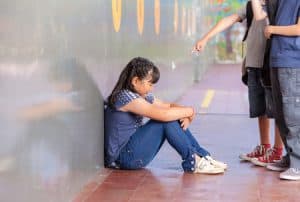[profileleft] [/profileleft]Many of us have had jobs or other daily requirements in the past that we dreaded. Many of us also got through those situations and looked back on them with an appreciation for what we had later in life. Adults have more of an ability to endure difficult situations because we have more experience and as a result perspective. Children simply do not have that experience given their age. When they dread something like school, it can inflict long-term harm on their self-worth and ultimately their quality of life. This is happening to too many children these days, according to a recent study. Many dread going to school and are having their lives negatively impacted by chronic bullying. We as a community need to stand up and fight this phenomenon. The children’s rights lawyers at Gomez Trial Attorneys are going to help by continuing to work to raise awareness.
[/profileleft]Many of us have had jobs or other daily requirements in the past that we dreaded. Many of us also got through those situations and looked back on them with an appreciation for what we had later in life. Adults have more of an ability to endure difficult situations because we have more experience and as a result perspective. Children simply do not have that experience given their age. When they dread something like school, it can inflict long-term harm on their self-worth and ultimately their quality of life. This is happening to too many children these days, according to a recent study. Many dread going to school and are having their lives negatively impacted by chronic bullying. We as a community need to stand up and fight this phenomenon. The children’s rights lawyers at Gomez Trial Attorneys are going to help by continuing to work to raise awareness.
About the Chronic Bullying Study
Researchers from Arizona State University completed the study. Those who wish to read it in its entirety can find it here. The study tracked 383 kindergarteners, including 190 boys and 193 girls. They attended public schools in Illinois. The researchers tracked the children from kindergarten through 12th grade. Every year, the subjects completed surveys that the researchers formulated. These surveys involved questions relating to different types of bullying. They included questions regarding whether that child had been the target of physical or verbal abuse during the year and other acts that would constitute bullying.
In addition to providing the surveys to the subjects, the researchers reviewed teacher evaluations and then looked into their standardized reading and mathematics test scores of those students. Finally, the researchers identified five different levels if intensity for bullying. These levels included:
- High-chronic bullying
- Moderate-emerging bullying
- Early victims of bullying
- Low victims of bullying
- Non-victims of bullying
Clearly, those who suffered from chronic bullying were bullied repeatedly and intensely. Moderate-emerging bullying involved bullying that tended to rise in frequency as children got older. Early victims were those who were bullied at younger ages but who did not suffer through as much of it as they aged. Low victims were children who suffered through periodic bullying. Non-victims, obviously, were not bullied during their school years.
The Chronic Bullying Study – The Findings
The researchers uncovered the following with regards to the percentage of students who endured chronic bullying and those who dealt with other levels of bullying:
- Chronic bullying – 24 percent of the subjects
- Moderate, increasing bullying – 18 percent of the subjects
- Decreasing bullying – 26 percent of the subjects
- No bullying – 32 percent of the subjects
In addition to the percentages, the researchers found the following in terms of how these levels of bullying affected the targets over time:
- Chronic bullying targets – These children experienced lower levels of academic achievement, disliked school more than others and had less confidence in their academic abilities.
- Increasing bullying – The children in this group suffered through similar struggles as those who had experienced chronic bullying.
- Decreasing bullying – Children in this category tended to show fewer academic effects than those in the subsets above, indicating that a child can overcome bullying with time.
This should not come as a surprise to many people, although it should be noted that the more we learn, the more we understand the long-term effects of bullying.
The Chronic Bullying Study – Breakdown by Grade
The researchers also broke down the intensity of the bullying that targets endured by grade. Below is that breakdown by percentage:
| Grade | Low Victims | Moderate Victims | Severe Victims |
| Kindergarten | 41.1 | 38.0 | 20.9 |
| 1 | 39.7 | 41.5 | 18.8 |
| 2 | 42.1 | 42.1 | 15.7 |
| 3 | 42.0 | 45.4 | 12.6 |
| 4 | 56.5 | 33.8 | 9.7 |
| 5 | 60.6 | 33.7 | 5.7 |
| 6 | 50.5 | 44.5 | 4.9 |
| 7 | 75.1 | 21.3 | 3.6 |
| 8 | 82.2 | 14.9 | 2.9 |
| 9 | 83.7 | 15.4 | 1.0 |
| 10 | 86.1 | 12.2 | 1.7 |
| 11 | 91.2 | 7.8 | 1.0 |
| 12 | 88.8 | 10.5 | 0.7 |
Based on the statistics above, it seems that the overall prevalence of moderate and intense bullying seems to begin to dissipate somewhat around 4th grade. That’s the point where of the students who were bullied, the number in the ‘low’ category moves above 50 percent. That category climbs continually going forward.
The Chronic Bullying Study – What It Could Mean
Perhaps the most striking revelation from this study is that nearly 25 percent of school children are the targets of chronic bullying. That means that on average, nearly one out of every four children are verbally abused, physically abused, emotionally abused or manipulated or in some way or ways mistreated on almost a daily basis.
According to the National Center for Education Statistics, or NCES, more than 49 million children attend public schools who are between kindergarten and 12th grade in the United States. If 24 percent of all public-school children suffer from chronic bullying, then 11.784 million kids are enduring almost daily misery. That is the equivalent of the populations of New York and Los Angeles combined. It could also spell trouble for millions of children when they move into adulthood.
What You Can Do To Help
Fortunately, there are things that you can do in order to help prevent chronic bullying and other types of bullying. The first step you can take is to commit to yourself, to others or both that you are going to step in when you suspect that bullying is taking place. If you do so, you should come to recognize the warning signs of bullying. We have detailed common warning signs recently. Beyond recognition, you will need to take action.
Basically, you need to make yourself heard. If you suspect the presence of bullying, speak to administrators at school if that’s where it may be taking place. If that doesn’t make a difference, try to speak to officials from the school district. You can also speak to other parents who may share your concerns. Collective action sometimes forces a response.
Of course, if your child is suffering and you are unsure of what to do to put a stop to it as soon as possible, you should seek the help of children’s rights lawyers who understand what it takes to hold those responsible for the safety of young people accountable. Contact Gomez Trial Attorneys today for a free case evaluation.







